How to Prune Bonsai Trees: A Step-by-Step Guide to Perfect Shaping
- March 29, 2024
- 0 comment
Learn How to Prune Bonsai Trees, a guide that combines horticulture with the art of bonsai. This introduction to bonsai pruning is designed for beginners, focusing on techniques to enhance both the health and beauty of your miniature trees.

List on How to Prune Bonsai Trees
- Tools You’ll Need
- When to Prune
- Maintenance Pruning
- Structural Pruning
- Healing and Care Post-Pruning
- Tips for Success
Understanding Bonsai Pruning
Pruning a bonsai is not just about maintaining its size but is a form of artistic expression. It involves two main types: maintenance pruning, which keeps the tree small and encourages new growth, and structural pruning, which shapes the tree and defines its overall look.
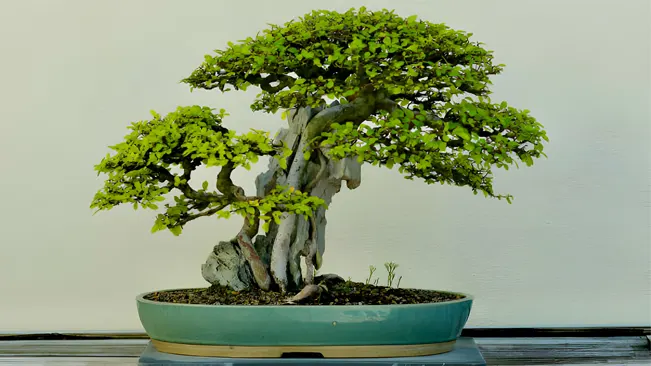
Maintenance Pruning
- Purpose: The primary goal of maintenance pruning is to control the size of the bonsai and maintain its current shape. It’s also about encouraging healthy growth and renewing the foliage to keep the tree vibrant.
- Technique: This involves regularly trimming back new shoots and leaves. It helps in maintaining the desired silhouette of the bonsai and prevents the tree from reverting to its natural, untrained shape.
- Timing: This type of pruning is usually done during the growing season. The frequency depends on the growth rate of the specific bonsai species.
Structural Pruning
- Purpose: Structural pruning is about shaping the tree and establishing its form. It is more strategic and less frequent than maintenance pruning. This type of pruning contributes significantly to the bonsai’s long-term appearance and style.
- Technique: This involves removing unnecessary branches, selecting primary branches to form the structure, and occasionally making significant cuts to direct growth in a certain way. Structural pruning can dramatically alter the tree’s appearance and should be done with a clear vision in mind.
- Timing: Often done during the dormant season when the tree’s structure is more visible without leaves. However, timing can vary based on the tree species and the specific goals of the pruning.
Artistic Expression
- Vision: Every bonsai artist should have a vision or a mental image of what they want their bonsai to look like. This vision guides every cut and decision in the pruning process.
- Adaptability: Sometimes, the tree’s natural growth pattern necessitates changes in the original vision. Successful bonsai pruning often involves a balance between guiding the tree and adapting to its natural tendencies.
Tools You’ll Need
Bonsai Pruning Scissors
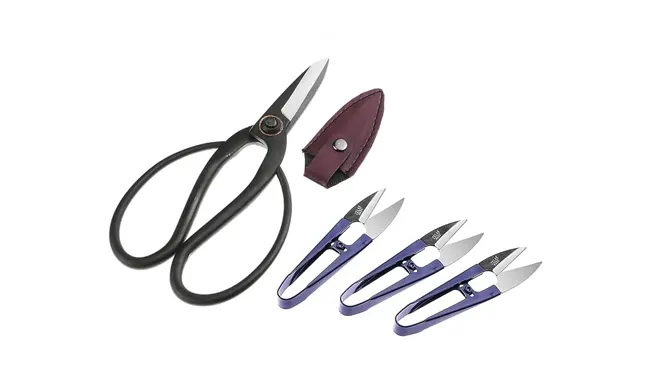
- Purpose: These scissors are specifically designed for pruning bonsai trees. They are perfect for delicate trimming and fine-tuning the shape of your bonsai.
- Design: Bonsai scissors have a sharp, precise edge and are often made of high-quality steel. This allows for clean cuts that promote better healing in the plant.
- Usage: Ideal for cutting smaller branches, twigs, and leaves. The design allows for close access to the trunk and branches without damaging the rest of the plant.
Concave Cutters
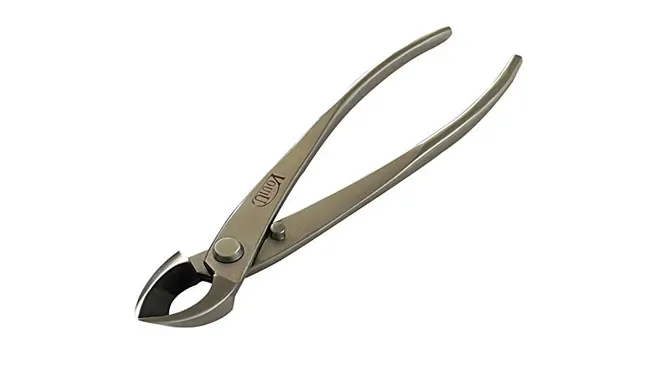
- Purpose: Concave cutters are used for making heavier cuts, particularly when you need to remove larger branches.
- Design: The unique concave shape of the blade creates a hollow cut. This design is crucial as it helps the wound left by the removed branch to heal over smoothly with minimal scarring.
- Usage: When a branch is removed using concave cutters, the resulting wound is smaller and neater compared to what standard cutters would leave. This not only improves the aesthetic but also enhances the tree’s health by reducing the risk of infection.
Wire Cutters
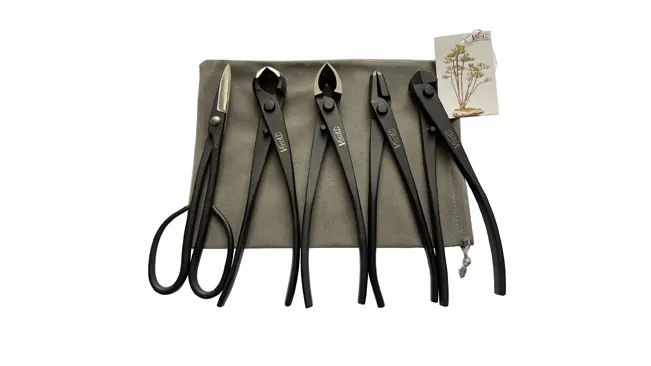
- Purpose: In bonsai, shaping branches often involves the use of wires. Wire cutters are essential for removing or adjusting these wires without damaging the tree.
- Design: Bonsai wire cutters are designed with a rounded head to snip the wire cleanly without leaving any protruding edges that could harm the tree’s bark or branches.
- Usage: They are used to cut the wire at the right length for wrapping and to remove the wire once the branch has set in its new position. It’s important to be careful when removing wire to prevent damaging the branch.
When to Prune
Pruning during the correct time of the year is essential because it influences how well the tree will recover and continue its growth. Pruning at the wrong time can stress the tree, leading to poor health or growth issues.
Growth Season: Spring and Early Summer
- Spring: This is when most bonsai trees begin their growth cycle. Pruning in spring allows the tree to heal quickly and put its energy into new growth. It’s the ideal time for heavy pruning, especially for structural shaping.
- Early Summer: This period is still part of the active growth phase. Maintenance pruning can be done during this time to refine the shape of the tree as it continues to grow.
Species-Specific Pruning Times
- Different species of bonsai trees have varying growth patterns and cycles. For example, deciduous trees are best pruned in late winter or early spring before new leaves appear, while many tropical species, which grow year-round, can be pruned more frequently.
- Coniferous bonsai, like pines or junipers, have different pruning schedules. For instance, pines are often pruned in mid-summer to control growth, while junipers can be pruned in late spring or early summer.
Other Considerations
- Health of the Tree: Ensure your bonsai is healthy before undertaking extensive pruning. A stressed or sick tree may not recover well from pruning.
- Pruning for Flowers and Fruits: If your bonsai produces flowers or fruits, you may want to time your pruning to maximize these displays. For example, prune after flowering in species where flowers appear on new wood.
Maintenance Pruning
Maintenance pruning is essential for sustaining the health and aesthetic appeal of a bonsai. It focuses on controlling the size and shape of the tree, ensuring that it remains true to its intended design. This type of pruning is typically more frequent and less drastic compared to structural pruning.
Identifying New Growth

- Purpose: The goal here is to maintain the tree’s size and desired shape. New growth, if left unchecked, can alter the silhouette and balance of your bonsai.
- How to Identify: Look for shoots and leaves that extend beyond the tree’s outline or seem out of place with the rest of the foliage. These often appear at the tips of branches or at the crotch where branches divide.
Trimming Back Shoots

- Technique: Use bonsai scissors, which are designed for precise and clean cuts, to trim these new shoots.
- Guidelines: Generally, it is advised to leave about two leaves on each shoot after pruning. This technique encourages the tree to grow more compactly and increases leaf density.
- Attention to Detail: It’s important to make cuts at a slight angle, just above a leaf pair. This encourages new growth in a controlled direction, contributing to the tree’s aesthetic form.
Thinning
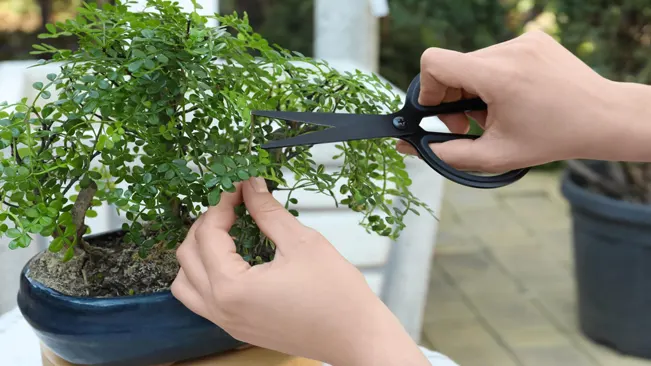
- Purpose: Thinning is crucial for allowing light and air to penetrate the inner canopy of the tree. This improves overall health, reduces the risk of disease, and stimulates growth in lower and interior parts of the tree.
- Approach: This involves selectively removing entire branches. Focus on branches that are:
- Crowding others or growing inwards towards the trunk.
- Duplicating another branch’s path.
- Disrupting the tree’s overall design.
- Tools and Technique: Use concave cutters for a cleaner cut that heals better. Make the cut as close to the trunk or parent branch as possible without damaging the bark collar (the swollen area where the branch joins the trunk).
- Considerations: Thinning should be done thoughtfully. It’s not just about removing branches, but about enhancing the tree’s structure and ensuring that each remaining branch receives adequate light and air.
Structural Pruning
Structural pruning is fundamental in defining the long-term appearance and health of a bonsai tree. This practice goes beyond mere maintenance and into the realm of artistic sculpting. Here’s a more detailed look at each step:
Developing a Vision
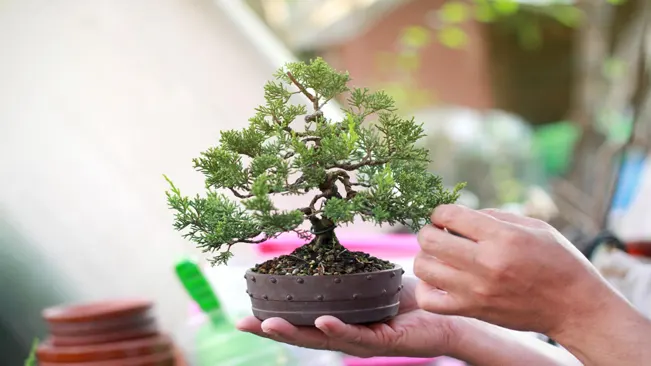
- Artistic Approach: Consider bonsai art forms like informal upright, cascade, or literati. Your vision should align with one of these styles or another you prefer.
- Observation: Look at your tree from different angles. Its natural inclination, trunk shape, and existing branch structure can guide your vision.
- Sketching: Sometimes, it’s helpful to sketch your vision. This can give you a clearer idea of what you’re aiming for.
Identifying Primary Branches
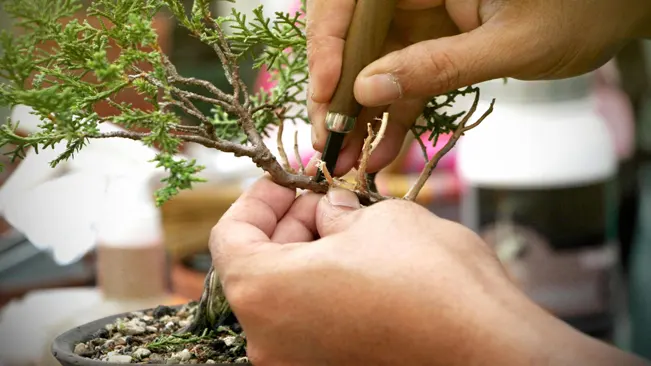
- Hierarchy of Branches: The primary branches form the skeleton of your bonsai. Typically, you’ll choose thicker, well-placed branches that contribute to the overall shape.
- Balance and Proportion: Ensure the branches you select maintain a sense of balance. Avoid cluttered areas and ensure a harmonious distribution of foliage.
Removing Unwanted Branches

- Selective Pruning: Identify branches that disrupt the flow, like those growing straight up or down, or ones that are too close to each other.
- Technique: Use concave cutters for clean cuts. Cut just above the branch collar (the slight swelling where the branch meets the trunk) but not into the trunk itself. This ensures better healing.
Shaping Branches
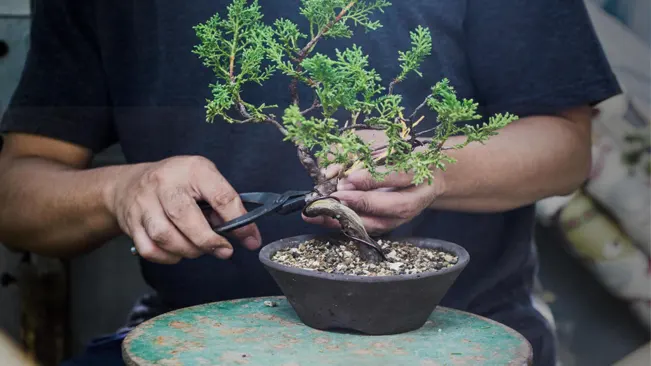
- Wiring: After pruning, wiring helps in directing the new growth. Choose the appropriate thickness of wire to match the branch size.
- Methodology: Wrap the wire around the branches you wish to shape. The idea is to bend them gradually over time to achieve the desired form.
- Safety: Ensure that the wire is tight enough to hold but not so tight that it cuts into the bark. Regularly check and adjust the wires to prevent them from scarring the branch as it grows.
Healing and Care Post-Pruning
Watering
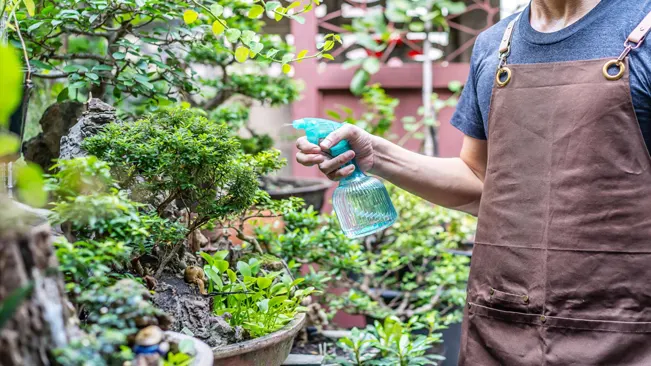
- Right After Pruning: Water your bonsai thoroughly immediately after pruning. This helps to reduce stress and aids in recovery.
- Regular Watering: Continue with a regular watering schedule, but be mindful not to overwater. The amount of foliage has been reduced, which can affect how quickly the soil dries out. Check the soil moisture daily.
Light Requirements
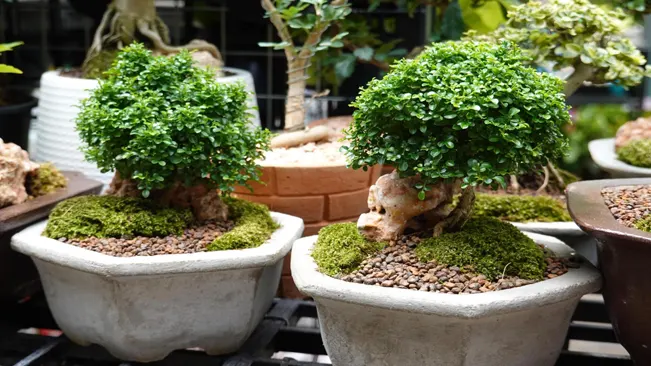
- Avoid Direct Sunlight: Right after pruning, especially if major cuts were made, it’s wise to keep the bonsai in a location where it receives indirect sunlight. Direct, harsh sunlight can stress the plant.
- Gradual Exposure: Gradually reintroduce the bonsai to its normal lighting conditions over a few weeks, monitoring its response.
Fertilization
- Wait Before Fertilizing: It’s generally recommended to wait a few weeks after pruning before applying fertilizer. This allows the bonsai to heal without the stress of new growth.
- Balanced Fertilizer: When you do fertilize, use a balanced, slow-release bonsai fertilizer to encourage healthy growth without overstimulating the tree.
Temperature and Environment
- Protect from Extremes: Newly pruned bonsai trees are more sensitive to environmental stress. Keep them in a stable environment, protected from extreme temperatures and harsh elements.
- Humidity: If your environment is particularly dry, consider increasing humidity around the bonsai to help it maintain moisture.
Monitoring for Pests and Diseases
- Regular Checks: Keep an eye out for signs of pests or disease. Fresh cuts can sometimes attract pests or become entry points for disease.
- Hygiene: Keeping the area around your bonsai clean and well-ventilated helps prevent the onset of fungal diseases.
Allowing Time to Heal
- Patience is Key: After pruning, give your bonsai time to recuperate. Avoid repotting or additional major stressors for a while.
- Observation: Watch how your bonsai responds in the weeks following pruning. Some trees bounce back quickly, while others may take longer.
Tips for Success
Always Use Sharp Tools

- Prevent Damage: Dull tools can crush or tear branches and leaves, leading to unnecessary damage and stress for the tree.
- Precision Pruning: Sharp tools allow for cleaner, more precise cuts. This is essential in bonsai where every cut impacts the overall appearance.
- Tool Maintenance: Regularly sharpening and cleaning your tools not only benefits the tree but also extends the life of your tools.
Study Your Tree and Understand Its Natural Shape
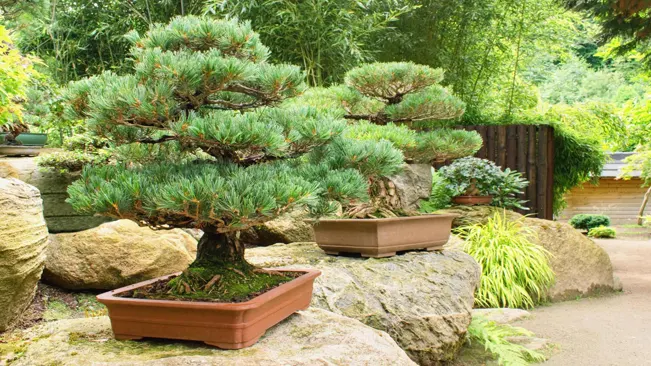
- Observe Growth Patterns: Each species of bonsai has a natural growth habit and style. Understanding this helps in making pruning decisions that complement the tree’s inherent form.
- Work With, Not Against Nature: Trying to force a tree into an unnatural shape can be harmful. Observing the natural lines and flow of the tree can lead to a more harmonious and sustainable design.
- Seasonal Changes: Be aware of how your tree changes through the seasons. This knowledge can guide when to prune and how to anticipate future growth.
Be Patient and Prune Gradually
- Long-term Process: Bonsai cultivation is a long-term art form. Quick, drastic changes are often not feasible and can be harmful.
- Step-by-Step Approach: Make small changes and allow the tree to recover. Over time, these small adjustments will amount to significant transformation.
- Learn from Each Step: As you prune gradually, you’ll see how your tree responds to each cut. This feedback is invaluable in understanding your specific bonsai’s needs and reactions.
Additional Insights
- Balance Aesthetics and Health: While shaping your bonsai, always keep the health of the tree in mind. A healthy bonsai will naturally look more beautiful.
- Use References: Look at examples of well-pruned bonsai trees, especially those of the same species as yours. This can provide inspiration and practical insights.
- Seek Advice: If possible, seek guidance from more experienced bonsai enthusiasts or join a local bonsai club for hands-on advice and support.
Conclusion
Pruning a bonsai tree is a delicate art that balances aesthetic design with the natural growth of the tree. For beginners, it’s important to understand the basics of pruning, the tools required, and the unique needs of your bonsai species. With practice, patience, and a bit of creativity, you can master this ancient art and enjoy the beauty of bonsai in your own home.
FAQs (Frequently Asked Questions)
- What is the best time of year to prune a bonsai tree?
- Most bonsai trees should be pruned during their growth season, typically in the spring or early summer. However, timing can vary depending on the species, so it’s important to research your specific type of bonsai.
- Most bonsai trees should be pruned during their growth season, typically in the spring or early summer. However, timing can vary depending on the species, so it’s important to research your specific type of bonsai.
- How often should I prune my bonsai tree?
- The frequency of pruning depends on the growth rate of your bonsai. Fast-growing species may require pruning every few weeks during the growing season, while slower-growing varieties might only need pruning once or twice a year.
- The frequency of pruning depends on the growth rate of your bonsai. Fast-growing species may require pruning every few weeks during the growing season, while slower-growing varieties might only need pruning once or twice a year.
- What tools are needed for bonsai pruning?
- Essential tools include bonsai pruning scissors for delicate trimming, concave cutters for larger branches, and wire cutters for shaping with wires.
- Essential tools include bonsai pruning scissors for delicate trimming, concave cutters for larger branches, and wire cutters for shaping with wires.
- How do I know which branches to prune on my bonsai?
- Focus on removing branches that disrupt the tree’s desired shape, such as those growing straight upwards or downwards, crossing over each other, or disrupting the symmetry of the tree.
- Focus on removing branches that disrupt the tree’s desired shape, such as those growing straight upwards or downwards, crossing over each other, or disrupting the symmetry of the tree.
- Is it possible to over-prune a bonsai tree?
- Yes, over-pruning can stress the tree. It’s important to prune gradually and not remove more than 1/3 of the foliage at a time.
- Yes, over-pruning can stress the tree. It’s important to prune gradually and not remove more than 1/3 of the foliage at a time.
- How do I care for my bonsai after pruning?
- Ensure the tree receives adequate water, light, and fertilization. Protect it from extreme conditions as it will be more vulnerable after pruning.
- Ensure the tree receives adequate water, light, and fertilization. Protect it from extreme conditions as it will be more vulnerable after pruning.
- Can I prune a bonsai tree to any shape?
- While you have creative freedom, it’s important to consider the natural growth pattern and health of the tree. Some styles may not be suitable for certain types of bonsai.
- While you have creative freedom, it’s important to consider the natural growth pattern and health of the tree. Some styles may not be suitable for certain types of bonsai.
- What is the difference between maintenance pruning and structural pruning?
- Maintenance pruning involves trimming new growth to maintain size and shape, while structural pruning is more about shaping the tree and defining its overall aesthetic.
- Maintenance pruning involves trimming new growth to maintain size and shape, while structural pruning is more about shaping the tree and defining its overall aesthetic.
- How do I handle large cuts on my bonsai?
- For larger cuts, use concave cutters to leave a hollow wound that heals with less scarring. Apply a healing paste if necessary to protect the cut area.
- For larger cuts, use concave cutters to leave a hollow wound that heals with less scarring. Apply a healing paste if necessary to protect the cut area.
- What should I do if my bonsai loses its shape after pruning?
- If the tree loses its desired shape, use wiring techniques to guide the branches as they grow back. Remember, shaping a bonsai is an ongoing process that requires patience and regular attention.

Kristine Moore
Forestry AuthorI'm Kristine Moore, a seasoned garden landscaping professional with over 30 years of experience. My extensive career has been dedicated to transforming outdoor spaces into stunning, sustainable landscapes. With a deep understanding of horticulture, design principles, and environmental stewardship, I have become a respected figure in the field, known for creating harmonious, visually appealing, and eco-friendly gardens. My commitment to excellence and continuous learning in landscaping trends and techniques has solidified my reputation as an expert in garden design and implementation.













Leave your comment